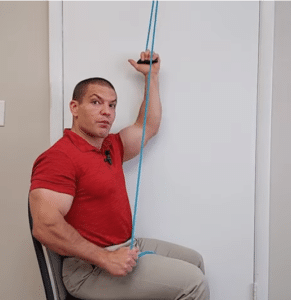If you have shoulder pain or a rotator cuff injury, you may have done shoulder pulley exercises during your physical therapy sessions.
Although shoulder pulley exercises can be really helpful tool for rehabbing a shoulder injury, many people do them wrong.
Watch the video to learn some common errors that people make when doing pulley exercises for shoulder pain, and how to do them correctly.

Common Mistakes With Pulley Exercises For Shoulder Pain
If you're going to do pulley exercises for shoulder pain, you want to make sure you're doing them correctly.
In this post, we'll cover some common pulley exercises for shoulder pain, the common mistakes people make with each exercise, and how to fix them.
Pulley Exercises For Shoulder Flexion
Shoulder flexion is the motion of moving your arm upward in front of your body.
This is one of the most common ways that you use your shoulder in everyday life. It's also the most common pulley exercise for shoulder pain.
When doing this exercise, you grip the pulley handle and raise your arm up in front of you.
You may have to adjust the length of the rope attached to the pulley or choke up on the rope (shown above) in order to allow a full range of motion.
Shoulder Pulley Exercise Error #1: Body Positioning
When doing a shoulder flexion exercise, you typically sit facing toward the door or sitting with your back toward the door as shown above.
In either of these cases, the pully is centered over your head.
That means that the higher you raise your arm, the more toward your midline your shoulder will go.
This places your arm in a position of relative internal rotation.
The internal rotation position of the shoulder brings a bump called the greater tuberosity under the arch of the shoulder, which can pinch the rotator cuff tendons.
This is known a shoulder impingement syndrome.
Shoulder Pulley Exercise Error #2: Stationary Axis Of Rotation
Another common error when using the pulleys is treating the shoulder like a stationary axis of rotation, like a bicep curl.
However, the shoulder does not move in a stationary axis of rotation when moving your shoulder during daily life activities.
The axis of motion has to move because your shoulder blade moves upwards as you raise your arm upwards.
How To Perform The Pulley Exercise For Shoulder Flexion Correctly
To fix both of these problems, turn your chair sideways to the door and focus on sliding your arm up the wall.
This keeps your arm in a position of shoulder external rotation, which prevents shoulder impingement.
As you slide your arm up the wall, allow your shoulder blade to move with it as well. You should be moving both your shoulder blade and your arm during this exercise.
RangeMaster BlueRanger Shoulder Pulley w...
$13.97 (as of July 25, 2024 15:36 GMT -05:00 - More infoProduct prices and availability are accurate as of the date/time indicated and are subject to change. Any price and availability information displayed on [relevant Amazon Site(s), as applicable] at the time of purchase will apply to the purchase of this product.)Pulley Exercises For Shoulder Abduction
Shoulder abduction is the motion of moving your arm out to the side away from the midline of your body.
Abduction is another common pulley exercise for shoulder pain that people do in physical therapy.
However, much like shoulder flexion, there are some common mistakes that you want to avoid when doing shoulder abduction exercises with a pulley.
Common Mistakes With The Shoulder Pulley Abduction Exercise
During the pulley shoulder abduction exercise, a common error is allowing your wrist to go in front of your elbow.
Much like the pulley shoulder flexion exercise, this also places your shoulder is in an internally rotated position.
How To Do The Pulley Exercise For Shoulder Abduction Correctly
A solution is to bring your elbow forward and rotate your wrist backward with palm facing forward so that your am is an externally rotated position.
As you raise your arm out to the side, allow your shoulder blade and arm to move together.
This creates a slight trunk side-bending motion away from the shoulder that you're moving. This is supposed to happen when moving your shoulder blade properly.
Pulley Exercises For Shoulder External Rotation
External rotation is the motion of rotating your forearm around the long axis of your upper arm bone toward the back of the hand. When your elbow is at your side, the axis of rotation is vertical and your hand moves away from your midline.
Shoulder external rotation exercise with a pulley are less common than shoulder flexion and abduction.
For this exercise, you place the pulley sideways in the doorframe rather than over the top of the doorway.
Biomechanically, there's nothing wrong with the shoulder pulley external rotation exercise.
However, it's a bit more cumbersome to do than just using a dowel rod or a broomstick for shoulder external rotation.
The verdict?
If you have a shoulder pulley and want to use it to do external rotation exercises, that's perfectly fine.
However, I wouldn't recommend going out and buying a shoulder pulley just for the purpose of doing shoulder external rotation
RangeMaster BlueRanger Shoulder Pulley w...
$13.97 (as of July 25, 2024 15:36 GMT -05:00 - More infoProduct prices and availability are accurate as of the date/time indicated and are subject to change. Any price and availability information displayed on [relevant Amazon Site(s), as applicable] at the time of purchase will apply to the purchase of this product.)Pulley Exercises For Shoulder Internal Rotation
One shoulder exercise that should never be performed with a pulley is internal rotation behind your back.
This exercise may be good in theory if you have difficulty reaching behind your back.
However, the shoulder blade (scapula) tips forward and can start to cause pinch your rotator cuff tendons.
Additionally, the ball of the shoulder (humeral head) starts to glide forward when your elbow goes really far behind your back.
This can also cause pinching of the rotator cuff tendons.
So that begs the question:
If you shouldn't do pulley exercises for shoulder internal rotation, what should you do?
For the answer to that, you might try checking out this post on shoulder pain reaching behind your back.
This post will give you some self-treatment tips to help you reach behind your back more comfortably.
However, often you get much faster improvement in your range of motion by getting manual physical therapy for your shoulder pain.
Manual physical therapy may consist of mobilizing joints in the the shoulder, neck, and/or upper back.
It may involve using trigger point therapy to release stiff knots in your shoulder muscles.
Or, in some cases treatment may involve dry needling.
In MOST cases, proper treatment for shoulder pain requires some combination of the hands-on treatments mentioned above along with some simple exercises. In many cases, those exercises don't even involve a pulley.
Need Treatment For Shoulder Pain?
If you'd like to find what treatments will help get your shoulder feeling better as quickly as possible, tap the button below to request an appointment with one of our specialist physical therapists.
Like this post? Here are some other posts about shoulder pain that you might enjoy:
Can't Lift Arm Above Shoulder Without Pain?
Can I Exercise With Rotator Cuff Injury?
8 Exercises For Rotator Cuff Strengthening Plus Common Mistakes To Avoid
Shoulder Pain When Arms Raised? These 2 Simple Tips Can Help!
How Do I Know If I Need Shoulder Surgery For A Rotator Cuff Tear?













